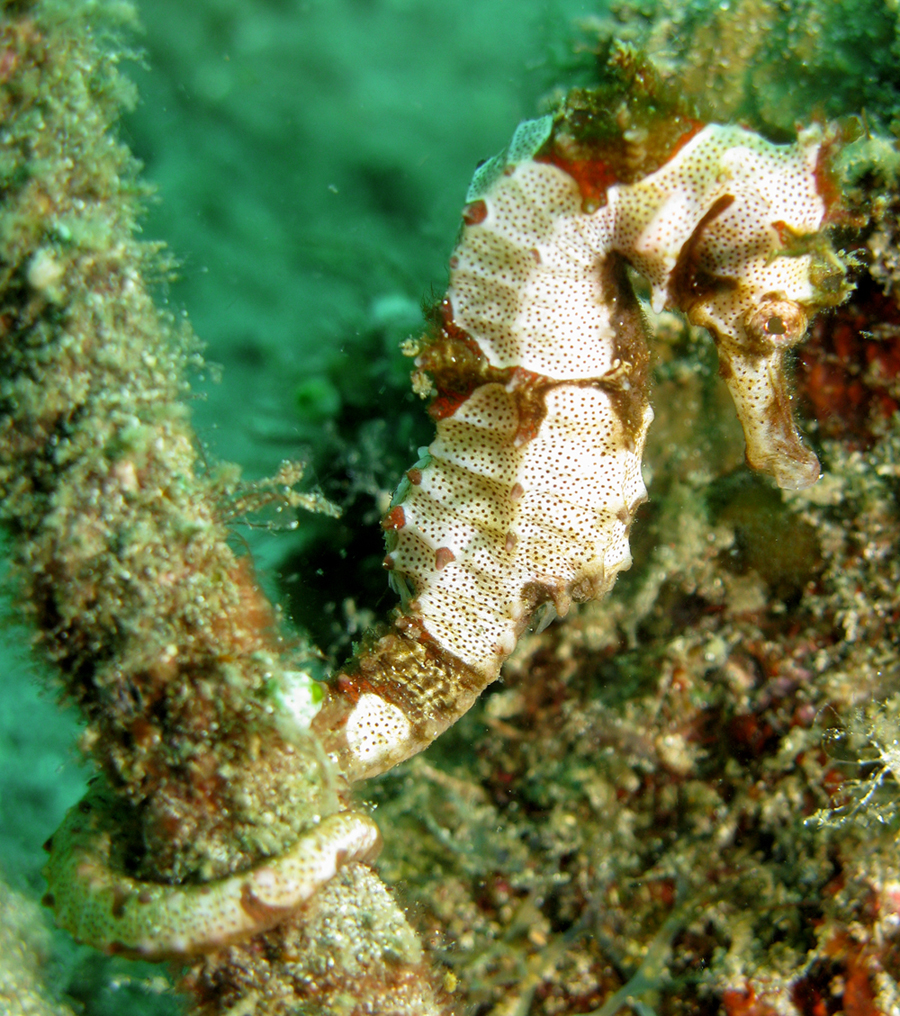Winged Seahorse, Hippocampus alatus Kuiter 2001

A Winged Seahorse, Hippocampus alatus, in Lembeh Strait, Sulawesi, Indonesia. Source: Steve Childs / Flickr. License: CC by Attribution
This distinctive seahorse, with its large wing-like spines on the ridges along its back, often lives in areas subject to strong currents, such as deep channels between reefs and islands.
Winged Seahorse, Hippocampus alatus Kuiter 2001
More Info
|
Distribution |
Tropical Southwest Pacific, in northern Australia and southeastern Papua New Guinea; in Australian waters, found from the Dampier Archipelago, WA, to the tip of Cape York, Qld. Benthic on soft bottom habitats at 10-80 m, usually amongst remote debris or coral outcrops, often in deep channels between reefs and islands which are prone to strong current movement. In Papua New Guinea the species also occurs on deep open sandy slopes with a few sponges and gorgonian corals to provide protection, in an area influenced by strong tidal currents. |
|
Features |
Meristic features: D 15-18 (usually 17); A 4; P 16-18; trunk rings 11; tail rings 34-36; subdorsal rings 2 + 1. Body slender and elongate; head large, 85% of trunk length; snout deep. |
|
Size |
Reaches a height of 180 mm. |
|
Colour |
In life, pale pinkish-white with numerous minute dark spots and broad reddish-grey saddle-like markings over trunk, on anterior part of tail and around the eyes. In preservative - adults pale creamy-white with numerous tiny brown spots and dark saddle-like markings on trunk and anterior part of tail around enlarged spines on superior ridges; dermal flaps dark brown to black. |
|
Feeding |
Carnivorous, food items unknown. Like other seahorses, the Winged Seahorse presumably feeds by sucking small crustaceans and other planktonic organisms into its mouth. |
|
Biology |
Sexes separate, reproduction a form of viviparity or ovoviviparity, whereby the males give birth to tiny independent young. The female uses an ovipositor to transfer her eggs into an elaborate enclosed pouch under the abdomen of the male. The male not only fertilizes the eggs inside the pouch and provides physical protection for the developing embryos, he also osmoregulates and aerates the embryos and may provide some nourishment until the offfspring are born. |
|
Fisheries |
Specimens are caught and discarded as bycatch by the prawn trawl fishery. There is no known international trade in the Winged Seahorse for the aquarium or Asian Traditional Medicine industries. |
|
Conservation |
CITES: Listed under Appendix II of the Convention on the International Trade in Endangered Species of Wild Flora and Fauna (CITES). As a result, the species is subject to the Convention, . |
|
Remarks |
Adult males are less spiny than females, and many rings may be smooth. |
|
Similar Species |
Prior to the formal description of Hippocampus alatus in 2001, the species had been misidentified as H. histrix, and H. barbouri, H. kuda and H. spinosissimus which are not found in Australian waters. The Winged Seahorse is most similar to H. queenslandicus, the Queensland Seahorse, differing in the development of spines along the tail. |
|
Etymology |
From the Greek, ippos = horse and kampe = curvature. Species name alatus from the Latin alatus, meaning winged, in reference to the outward-directed paired spines on the superior trunk ridges that have broad dermal flaps, resembling wings. |
|
Species Citation |
Hippocampus alatus Kuiter 2001, Rec. Aust. Mus. 53: 317, fig. 25, east coast of Cape York, QLD. |
|
Author |
Dianne J. Bray & Vanessa J. Thompson |
Winged Seahorse, Hippocampus alatus Kuiter 2001
References
Hoese, D.F., D.J. Bray, J.R. Paxton & G.R. Allen. 2006. Fishes. In Beesley, P.L. & A. Wells. (eds.) Zoological catalogue of Australia. Volume 35. ABRS & CSIRO Publishing: Australia, 2178 pp.
Kuiter, R.H. 2000. Seahorses, Pipefishes and their Relatives. TMC Publishing, Chorleywood, UK, 240 pp.
Kuiter, R.H. 2001. Revision of the Australian Seahorse of the genus Hippocampus (Syngnathiformes: Syngnathidae) with descriptions of nine new species. Rec. Aust. Mus. 53: 293-340.
Pogonoski, J.J., D.A. Pollard & J.R. Paxton. 2002. Conservation Overview and Action Plan for Australian Threatened and Potentially Threatened Marine and Estuarine Fishes. Canberra, Environment Australia, 375 pp.



